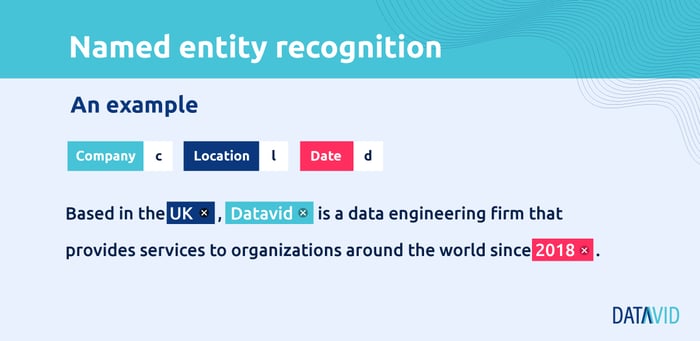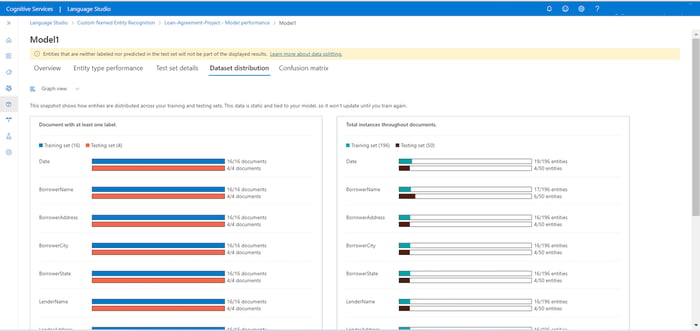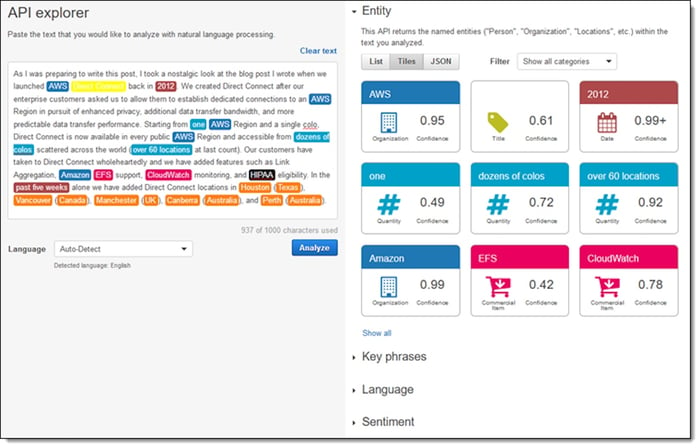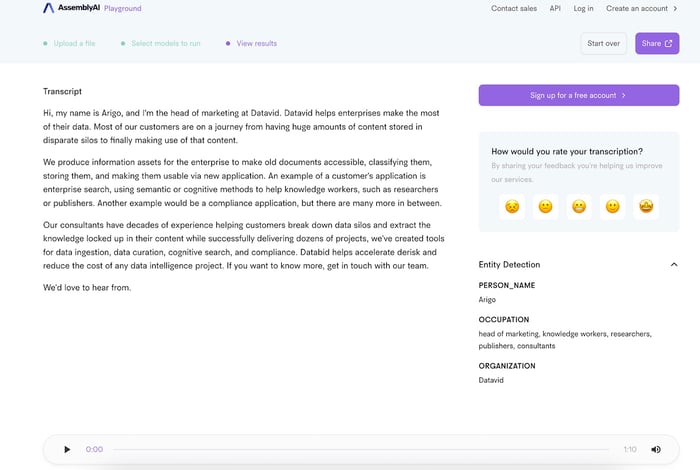7 minute read
Top 5 named entity recognition APIs to use in your app
Named entity recognition can help you process massive amounts of data. Learn which named entity recognition APIs will help your business run efficiently.
Table of contents
Named entity recognition, or NER, can be a valuable tool for your business, and there are several quality APIs available that can help you get more out of this concept.
Imagine having to read every word of every article about your industry you can find. This is probably not feasible, although many of these articles contain valuable information that can benefit your business.
With named entity recognition, you can scan text for specific keywords that let you know what each article is about, which provides a wealth of information on its own and helps you determine which ones to look closer at.
Here is an overview of named entity recognition (NER) with a focus on some of the best-named entity recognition APIs to use in your application.
What is named entity recognition?
Named entity recognition is a common NLP technique that can help you inspect and make sense of the information you want to understand and work with.
This method, which is also frequently referred to as entity detection, can quickly scan a document, identify words, and categorize them.
How does named entity recognition work?
Named entity recognition uses machine learning to automatically break up the text it is given and sort the terms it contains - called entities - into predetermined categories.
A NER tool can semantically analyse a piece of text to quickly pull out pull out specific pieces of information information and categorise them to provide information that you can be used to learn more about topics relevant to your company.
The named entity recognition process typically uses two distinct steps to make sense of information and assign it to a particular category, making it possible to use it according to the user's preferences.
The named entity recognition process begins by identifying terms within a particular document and then sorting this information into specific categories that allow the user to be more productive.
What is named entity recognition used for?
Named entity recognition can help you quickly identify key pieces of information in a wide range of material, such as names of specific people, locations, businesses or other organisations, and other entities that are mentioned in the text.

For example, this can help your business analyse information that may be useful when planning your own marketing strategies.
It is used in many industries, such as finance, marketing, hospitality, health care and a lot more, to take advantage of their data, especially the unstructured.
Why is named entity recognition important?
Named entity recognition can scan and categorise information in a much shorter time than a human would need, helping to determine the specific value that each article, social media post, or other type of text provides in the larger context of your organisation.
In short, it's a great time and money saver.
Top-named entity recognition APIs
Here are some of the top NER APIs offering a variety of features that may be a good fit for your business depending on cost, features, ease of implementation, reliability, and scalability.
1) Google Cloud NLP

Source: Google Cloud NLP (demo)
Google Cloud NLP joins Google's constantly growing suite of cutting-edge digital products that extend the boundaries of what technology can do for businesses. This natural language AI API prioritises creating content that comes as close to content created by a human as possible, which provides text analysis at a higher level that flows more clearly than what many AI programs are currently capable of providing.
This API is Google's more complex option, which means it targets larger businesses than its basic AutoML product.
Pros of Google Cloud NLP
Google Cloud NLP is a top choice among large international corporations because it provides some of the best multilingual named entity recognition and other AI content that is currently available. This API provides services in 10 different languages, which makes it a significantly more efficient option than finding humans with the language skills to handle the same projects.
In terms of features, it has text summarization, question answering, text generation, translation, language detection, tokenization, lemmatization, and sentiment analysis capabilities.
This program also provides several options to choose from, which can help you find a program that best fits your industry. These programs include:
- AutoML
- Natural Language API
- Healthcare Natural Language AI
Cons of Google Cloud NLP
Although this API is a strong option in the areas it does provide, Google Cloud NLP is somewhat more limited in the types of information it is currently capable of handling. Many users have found that this API needs significantly more training to be capable of performing fewer tasks than many of the other options on the market.
Google Cloud NLP is also a more expensive option than many of its competitors, which means it may be more difficult to experiment with than other options. Although this API provides free credits to new customers, the higher cost of this program may not be worthwhile once your business uses these credits and needs to shift to an ongoing subscription.
2) Microsoft Azure cognitive services

Source: Microsoft Azure Cognitive Services (tutorial)
Microsoft Azure Cognitive Services suite includes NER API services, which are hosted on Microsoft Azure, a platform that provides a dependable and flexible infrastructure. The API is straightforward to integrate via APIs and SDKs. It targets businesses of all sizes and industries that are interested in leveraging AI and machine learning capabilities to enhance their applications.
Pros of Microsoft Azure
Microsoft Azure Cognitive is a cost-effective platform that can handle multiple languages, making it useful for diverse applications globally. Developers can leverage this technology along with the Applied AI Services to tailor pre-built AI solutions. Another positive aspect of this tool is its focus on data security.
Cons of Microsoft Azure
Despite having a sufficient level of user-friendly, Azure showed a low accuracy rate in testing and had a significant latency period of more than 3200ms. Additionally, it needs to be expertly managed and maintained and requires platform expertise. Ultimately, it received poor ratings from users for its customer support.
3) Amazon Comprehend

Source: Amazon Comprehend (tutorial)
Amazon Comprehend is a natural language processing (NLP) service offered by Amazon Web Services (AWS). It uses machine learning algorithms to extract insights from text, such as sentiment analysis, entity recognition, and language detection. Amazon Comprehend targets businesses of all sizes and industries that want to extract insights from large volumes of text data. This includes industries such as health care, finance, retail, social media, and more.
Pros of Amazon Comprehend
Comprehend can process large volumes of text quickly, making it useful for a variety of applications. It is easy to use, with a simple API that developers can integrate into their applications without requiring expertise in machine learning or NLP.
Cons of Amazon Comprehend
While Amazon Comprehend supports several languages, its language support is still limited compared to other NLP services.
Amazon Comprehend's analysis capabilities are focused on specific types of text analysis, and it may not be suitable for businesses that require more advanced or specialised text analysis capabilities.
Also, Amazon Comprehend has a limited customization.
4) AssemblyAI

Source: AssemblyAI (demo version analysing a Datavid youtube video)
AssemblyAI is a versatile entity recognition API option that targets everything from small businesses to major enterprises. It specialises in revenue intelligence and conversation intelligence, areas that have not yet been explored in depth by a large number of similar programs.
This API goes beyond the basics of recognising relatively simple terms from text. AssemblyAI expands upon this emerging concept by transcribing large amounts of speech, distinguishing between speakers, and creating accurate summaries of the information that a document it is given contains.
Pros of AssemblyAI
AssemblyAI provides some of the API industry's leading statistics as far as the overall accuracy of the entities it identifies and categorises, which makes it a top choice among business owners that are interested in pushing the limits of what artificial intelligence tools are currently capable of and using the information AI provides to improve the efficiency and functionality of their businesses.
This API also prioritises frequently updating the types of information the program is capable of recognising, which makes it a frontrunner when it comes to adding to the overall range of ways businesses can benefit from adding an artificial intelligence API to their digital toolbox.
AssemblyAI is one of the most accurate speech-to-text API. It is generally better at using proper capitalisation and punctuation than many other AI programs, which means that the information it provides can be closer to the final product and require less extra work from a human to make the text it creates usable.
Also, you can use this API for free on a limited trial.
Cons of AssemblyAI
Although AssemblyAI is a strong platform overall and a good choice for many users, its versatility is somewhat limited because it is only a web-based program. There are no Android, iOS, or even desktop versions of this API available, which means that using this API on various devices can be slightly less convenient.
AssemblyAI also provides little to no information about how it integrates with other digital tools, which means that it may not blend as seamlessly with the other programs you are already using as alternative API options might.
5) Dandelion

Source: Dandelion API (demo)
Dandelion focuses on text analytics and semantics to help users understand whether the documents this API is viewing are primarily positive, negative, or neutral. This allows users to learn more about general views of certain topics, which can help them determine what angle would be the best choice for working with the information they learn.
This API primarily targets businesses that are interested in researching what their target audience is saying about various topics that are related to their industry, as well as how their competitors are handling them. Although it does not dig as deeply into what users may be able to do with this information, Dandelion provides a strong overview of what relevant information is currently available.
Pros of Dandelion
It has features like entity extraction, text similarity, language detection, sentiment analysis, and wikisearch.
Dandelion provides up to 1,000 free units per day, which can significantly reduce the amount of content that many businesses need to pay for. Although this may not necessarily be significant for especially large corporations, it can be enough to make Dandelion a strong choice for small businesses that are searching for ways to save money and do not plan on using the API as frequently.
Cons of Dandelion
Dandelion's heavy focus on semantics can keep it from being the best choice for certain businesses that are interested in digging deeper into the information their API provides instead of sticking to surface-level content.
Choose the right NER API for your business
Choosing the right Named Entity Recognition (NER) API for your business can be a daunting task, but here are some factors to consider that can help you make an informed decision:
- Accuracy: Search a NER API that offers high accuracy in recognising and extracting named entities from text data.
- Language support: Choose a NER API that supports the languages you need to analyse.
- Customisation: Consider whether the NER API can be customised to meet your specific business needs. Some APIs may offer the ability to train custom models on proprietary data, which can improve accuracy for your use case.
- Ease of use: Look for a NER API that is easy to use, with a simple API that developers can integrate into their applications without requiring expertise in machine learning or natural language processing.
- Scalability: Select a NER API that can handle the volume of text data you need to analyse and can scale as your business grows.
- Integration: Find out whether the NER API you are considering can integrate with other tools and services you are already using in your business workflow, such as data storage and analysis tools.
- Cost: Think about how much you can spend for a NER API, and find one that fits within your budget. Some APIs offer pay-as-you-go pricing, while others may require a subscription or licensing fee.
By considering these factors, you can choose an NER API that meets your company's needs and helps your business grow.
Frequently Asked Questions
What is Named Entity Recognition?
Named Entity Recognition (NER) is an NLP technique that identifies and categorises named entities in a piece of text, such as names of people, organisations, and locations.
What is an example of named entity recognition?
An example of NER is identifying the name of a person, such as "Barack Obama," in a sentence, and categorising it as a "person" entity type. Another example is identifying the name of a location, such as "New York City," and categorising it as a "location" entity type.
What are the methods of named entity recognition?
The methods of NER include rule-based methods, statistical methods (such as Hidden Markov Models and Conditional Random Fields), and deep learning methods (such as Recurrent Neural Networks and Transformers).


